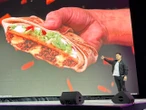Jagat Pun finds that working as a delivery driver is becoming harder and harder.
Pun spends his days zipping around New York City delivering Uber Eats orders, a job he’s done since 2020. But recently he’s had to work through the added burden of extreme heat, which makes waiting outside on sidewalks with no shade, navigating streets, and climbing up multiple flights of stairs in pre-war buildings all the harder.
“I get scared when the weather is really bad, but there’s not really anything I can do, because I have to work,” Pun, who is affiliated with the New York-based labor advocacy group Justice for App Workers, says in an interview with Fast Company that was conducted through a translator. ”Who else is going to be able to pay rent for my apartment? Who is going to be able to feed my family?”
Pun is one of the countless gig workers struggling to continue rapid pace deliveries during what’s been yet another record-breaking, extremely hot summer. Temperatures are continuing to hit all-time highs. Last month marked the hottest June on record, while some cities recorded temperatures up to 25 degrees above average.
The dangerous effects of extreme heat
Exerting the body in high temperatures is not only uncomfortable, but dangerous. Bodies need to be able to cool themselves down. The inability to regulate internal temperature can increase the risk of heat exhaustion and heatstroke, according to the World Health Organization. The heart and kidneys can also be strained as the body tries to cool itself. It’s not uncommon for people to be rushed into the emergency room for a range of symptoms like a rash or loss of consciousness. More than 1,200 people die from extreme heat every year in the U.S., according to the Centers for Disease Control and Prevention. In 2022, there were 43 confirmed heat-related workplace fatalities, though researchers think the annual number is actually in the thousands.
“The danger with extreme heat, which is often called the silent killer, is that the chronic effects of extreme heat exposure are really hard to identify outside of a clinical setting,” says Cascade Tuholske, a geographer at Montana State University. “From an acute perspective, you deal with heat exhaustion or fatigue, and many people need to stop working. But if you’re a gig worker, you can’t stop working.”
Repeated exposure to extreme heat can cause long-term effects, Tuholske adds, especially on the adrenal system. Issues can also manifest long after the exposure.
Being a gig worker, whether that means picking up orders on a bike or dashing in-and-out of stores, means there’s often little reprieve from the sweltering temps.
“When it gets really hot, people hide in the house. They don’t want to go out, so they just order for delivery,” says Gustavo Ajche, cofounder of Los Deliveristas Unidos and member of the Workers Justice Project advocacy group. “And then apps push workers to go faster and faster on the street.”
A spokesperson for the Occupational Safety and Health Administration tells Fast Company employers should provide employees with adequate water, rest breaks, and a cool area to rest. “They should also train workers on heat illness prevention, signs of heat illness,” the spokesperson adds, “and how to act immediately if they or another employee appears to be suffering from a heat-related illness.
Some gig giants have indeed taken steps to protect workers.
DoorDash, the leading food delivery platform, said that it has a range of actions it can take Including proactively sending safety tips (like staying hydrated and cool), switching to customer pick-up only, or even suspending service. They stressed that Dashers, which is what they call their gig workers, are ultimately in control of how and when they work. They can take breaks or choose not to work all together.
A Grubhub spokesperson made similar comments in a statement to Fast Company. “We won’t hesitate to pause orders in a market and follow guidance from local officials if the temperature becomes dangerously high,” the spokesperson said, adding that gig workers can decline orders without penalty.
An Uber Eats spokesperson didn’t respond to a request for comment.
“The thing with extreme heat is we have a lot of the tools we need to adapt to it already,” Tuholske said. “A lot of that comes through humane policy actions, through allowing people, no matter what their job is, to have the ability to stop working when it’s really hot out. But the key, especially for gig workers, is the ability to access those and still have a livelihood.”
The New York dilemma
In most cities, gig workers can take the advice of working in the cooler hours. But there’s not much workers in New York City can actually do if they want to continue making money thanks to a new minimum pay regulation that has caused gig companies to limit when people work.
New York City Council mandated a pay hike for gig companies last year. After much legal back-and-forth, the apps now have to pay workers a minimum wage per hour, or the equivalent if they choose to pay per delivery trip. But the companies haven’t been happy with these changes, since they’re fighting to turn a profit, and many say it’s harder to log in and work as much as they used to be able to.
Companies began restricting the hours people can work in the apps, a process that community organizers and gig workers are calling “lockouts.” So a person now has to jump at the opportunity to get into the app and make deliveries, regardless of the time of day or conditions.
“Back when I had started doing deliveries, if it was really hot or if the weather was really bad, I could take that time off and start work a couple of hours later,” Pun said. “But now, because of the conditions in New York with lockouts, I have to work when I get the chance. If that means working in extreme weather, then that’s what I have to do and figure out ways to cope.”
Pun and his fellow workers have come up with some ways to block the sun. People will wrap their faces with scarves or handkerchiefs, drink water, eat ice cream, and wear thin clothes that cover up their whole bodies, “because the sun feels like it’s burning our skin,” he says.
Still, platform workers in other cities often aren’t afforded traditional protections that are common for workers in traditional job markets. The Phoenix City Council, for example, passed a landmark rule in March that requires employers to provide access to heat protections and training for city contractors and subcontractors—but not gig workers.
Ultimately, advocacy groups are calling on the gig platforms to provide more support for workers via benefits like sick pay or insurance. They also want the gig companies to give the option for customers to tip back in the checkout tab, rather than waiting for the delivery to be completed.
“These big companies, they’re making a lot of money on the backs of a lot of people,” says Los Deliveristas Unidos’ Ajche.











No comments